Viotar/Quantifying the signal: Difference between revisions
| Line 53: | Line 53: | ||
==Software Design (Quantifying the signal we want to see)== | ==Software Design (Quantifying the signal we want to see)== | ||
With software design, we mean the way the controller is structured. There are many possibilities, but it is important to design the controller in such a way that it matches the requirements that are stated. The controller will be tested on a fixed point model of the string, so it is also important to verify that the model is accurate enough to represent the real string. Besides that, also the following questions need to be answered to come to a good software design: | With software design, we mean the way the controller is structured. There are many possibilities, but it is important to design the controller in such a way that it matches the requirements that are stated. The controller will be tested on a fixed point model of the string, so it is also important to verify that the model is accurate enough to represent the real string. Besides that, also the following questions need to be answered to come to a good software design: | ||
* Where does the "pleasant" sound come from that you hear when you stand next to the instrument when it's bowed? Is it mainly the vibration of the body that you hear? In that case it would origin mainly from the pressure variances of the string on the bridge, which translate into the body. On the other hand, it could be mainly the vibration of the string that you hear. In that case, the transversal wave as described by the computer model and measured by a laser sensor is dominant. The outcome of this will be important in the choice of what the capture and amplify exactly, when the instrument is done. | * Where does the "pleasant" sound come from that you hear when you stand next to the instrument when it's bowed? Is it mainly the vibration of the body that you hear? In that case it would origin mainly from the pressure variances of the string on the bridge, which translate into the body. On the other hand, it could be mainly the vibration of the string that you hear. In that case, the transversal wave as described by the computer model and measured by a laser sensor is dominant. The outcome of this will be important in the choice of what the capture and amplify exactly, when the instrument is done. | ||
* What do the following vibrations look like for different types of measuring instruments? | * What do the following vibrations look like for different types of measuring instruments? | ||
| Line 60: | Line 62: | ||
** Raucous noise (bow pressed too hard against the string) | ** Raucous noise (bow pressed too hard against the string) | ||
** Surface sound (bow pressed too softly against the string) | ** Surface sound (bow pressed too softly against the string) | ||
* How can we recognize a pleasant (Helmholtz) vibration in time and/or frequency domain? | * How can we recognize a pleasant (Helmholtz) vibration in time and/or frequency domain? | ||
* What kind of controller do we need to meet all of our requirements? | * What kind of controller do we need to meet all of our requirements? | ||
In order to answer these questions, some experiments have been done. These experiments give information about what a bowed string looks like in both time and frequency domain. When we are able to find out how to recognize a pleasant (Helmholtz) sound from time and/or frequency information, this is a first step in designing an appropriate controller. | In order to answer these questions, some experiments have been done. These experiments give information about what a bowed string looks like in both time and frequency domain. When we are able to find out how to recognize a pleasant (Helmholtz) sound from time and/or frequency information, this is a first step in designing an appropriate controller. | ||
Revision as of 18:08, 20 January 2011
Software Design (Quantifying the signal we want to see)With software design, we mean the way the controller is structured. There are many possibilities, but it is important to design the controller in such a way that it matches the requirements that are stated. The controller will be tested on a fixed point model of the string, so it is also important to verify that the model is accurate enough to represent the real string. Besides that, also the following questions need to be answered to come to a good software design:
Experiment plan
To measure raucous noise and surface sound, only the open A- and B-string will be measured. Goal of the measurementIn order to find out what a Helmholtz vibration and a noisy (in this case raucous) sound look like in the frequency domain, we did some experiments. We measure the vibration of the string in three ways. Firstly, we measure the transversal motion of the string, using a laser. This will be done because we need to know the vibration of the string at one single point, since the model also describes one point. Also the vibration at the bridge will be measured, using the existing piëzo’s. This is done because we want to know the difference between the vibration of the end of the string and the vibration at a single point somewhere in the middle of it. At last, we also measure the sound that you hear when the instrument is bowed, using a microphone. The main goal of these measurements is that we want to know how we can recognize a clear Helmholtz vibration in the frequency domain. Measurement setupThe measurement with the laser will be done using a Lab Interface. For the measurements with the piëzo’s and the microphone, we will use a SigLab. The experiments will be done for two different strings, the A and B string. The string will be bowed at 4 different fret positions, being the open string, the 1st, 12th and 13th fret. All the measurements will be done twice to reduce errors. ResultsIn figure 1 both the time and frequency domain results are given for what we call a raucous sound, which means that the string is sticking to much. This measurement is done using a piëzo guitar pickup. As can be seen from the power spectrum, there are no harmonic vibrations in this sound. It is all very chaotic and there is only noise. In figure 2 the results are given for what is called a surface sound, which means that the bow force is to low and the bow scratches against the string. In this figure there are some peaks that are clearly higher than others. These are the hormonic frequencies for a Helmholtz vibration as we will see later. Beside those peaks however, there is also a lot of noise in between them. This noise could be a thing that makes a surface sound recognisable later on.  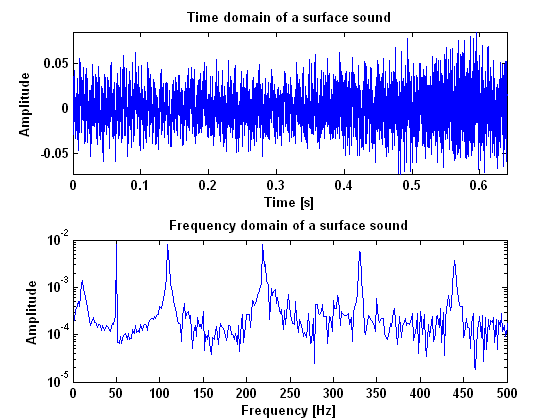
In figures 3, 4 and 5, the results are given for helmholtz vibration, measured with the microphone, the laser and the piëzo. As can be seen in these figures, a Helmholtz vibration gives clear harmonic peaks in the power spectrum. Especially the measurements done with the piëzo and the laser give a good result. Important to notice when the vibration is measured with the piëzo, is the peak at 50 Hz which is caused by the power supply. Beside that peak however, all the peaks appear in harmonic frequencies. When the result is compared to the result of the surface sound, it is clear to see that there is a lot less noise in a Helmholtz vibration. This may be very important in recognizing the type of the vibration and, more imporatant, make the difference between a surface sound and a helmholtz sound visible. 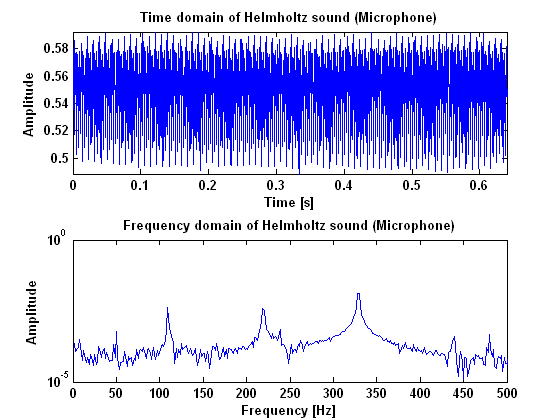 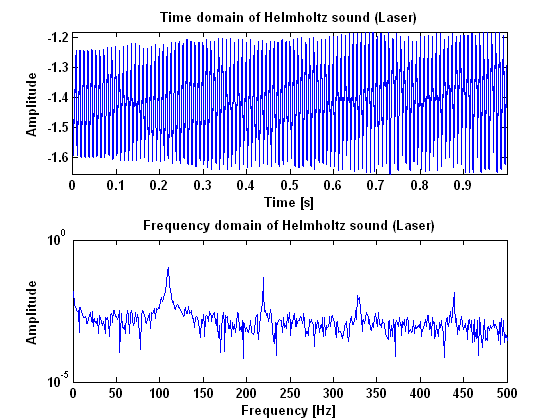 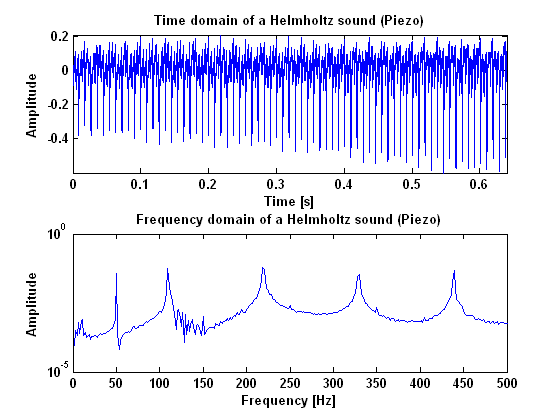 Analysing the resultsNoise cancellationThe first goal was to cancel the noise from the measurements using the pitch shifting method explained in the Experiment Plan. This has proved to be not as simple as we have thought. The power spectrum of a measurement may be split up in two components: the 'noise' component, which stays the same when a higher note is played, and the 'harmonic' component, which shifts up when a higher note is played. They may be written as [math]\displaystyle{ p_n }[/math] and [math]\displaystyle{ p_h }[/math], respectively, so that [math]\displaystyle{ p=p_h+p_n }[/math]. The two measurements are called '1' and '2', of which '1' will be pitch-shifted towards the pitch of '2'. The shifted measurement is called 's'. will yield these equations:
These are 4 equations with 6 unknowns, so the system can't be solved. Therefore, the measurements of the 1st and 13th frets are dropped, because they are now only excess measurements. Recognising Helmholtz and quantifying the signalProbaby, Helmholtz is the only harmonic vibration that you can get from a string when you bow it. With a bow you can never get a normal standing wave as when you would pluck the string. Because of this, it is not necessary to quantify "how much" the measured vibration is the specific Helmholtz waveform. It may suffit to merely quantify how harmonic the measured vibration is. This can be done by detecting the fundamental frequency in the fft of the signal, and looking looking how many multiplications of this frequency are still in the signal. The more overtones, the sharper the Helmholtz, and therefore the better the tone. In order to do this we made amplitude plots in the frequency domain. This gives us information about the frequencies at which high peaks appear and what their amplitudes are. We did this for the model as well as for our measurements. When we first analyzed the model, we seemed to be right in the fact that as the tone gets better, more peaks appear in the fft spectrum. These peaks are not randomly spread out, but appear at harmonic frequencies. That is, at n-times the fundamental frequency with n being the number of the peak. This is also made visible in the figures below. These figures show the difference between the frequency that you would expect following this rule and the frequency that comes out of the model. For an unidentifiable tone, there are no harmonic tones on the expected frequencies, as the graph runs out of the figure. For a clear Helmholtz vibration however, the rule is satisfied for nine peaks. A second thing that becomes clear by analyzing the results from the model, is that the amplitude of every next peak decreases exponentially. 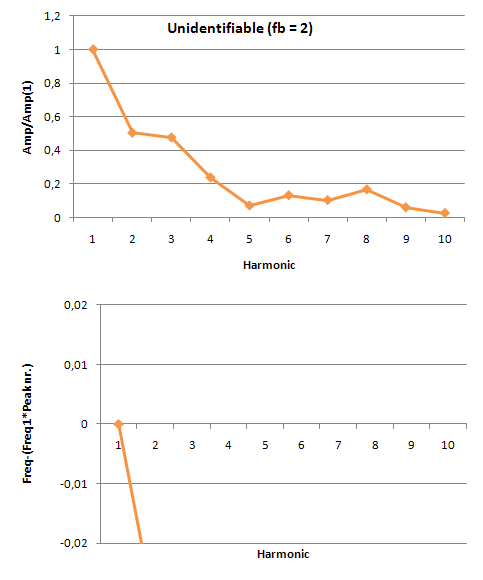 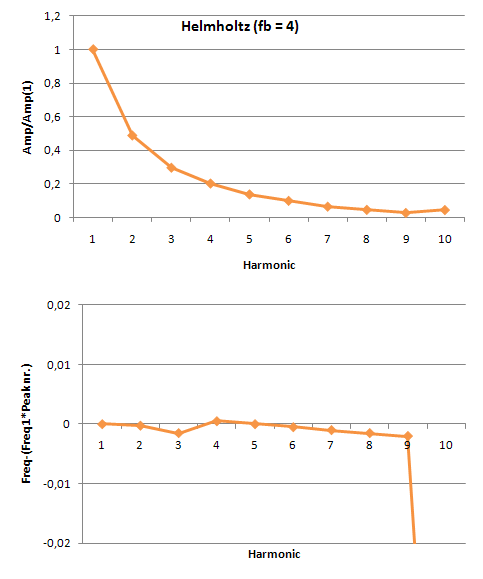
When we take a look at the measurements we did, it becomes clear that these measurements are not as “clean” as the model. The same figures as for the model are also made for the measurements, as you can see below. The amplitude of the peaks does indeed decrease more or less logarithmic as we would expect from the model. The number of peaks that appear at the expected frequency however, is only three for a vibration that sounded like a Helmholtz vibration to us. This can be explained by the fact that these measurements are done using a piezo element and the string vibrates along this element instead of perpendicular to it, which gives another signal. This problem is going to be solved however because in the meantime experiments have proofed that the signal gets better when the string vibrates perpendicular, like it will on our prototype. 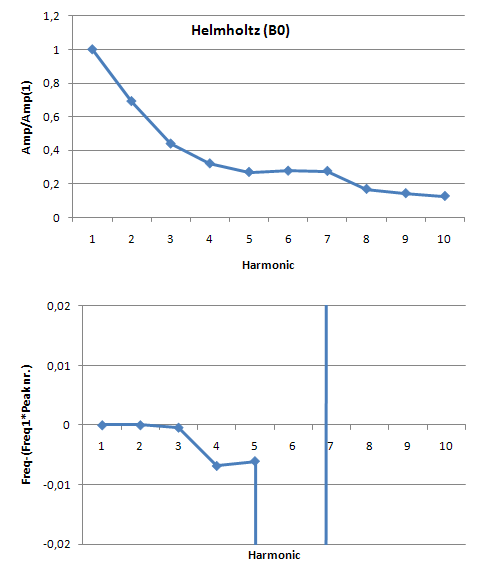 So, we seemed to be right in the fact that the quality of the vibration has something to do with the frequencies at which harmonic peaks appear and the amplitude of that peaks compared to that of the fundamental frequency. There is only one important thing that makes this method of quantifying the signal irrelevant for our prototype control system. The point is that for this method a fourier transformation needs to be done in the control unit in order to detect what the quality of the signal is. The problem is, that a fourier transformation cannot be done instantaneously but only when enough information about the vibration is gathered. A simple rule tells that the resolution of the fft equals 1/(sample time). In our case, where quality of the sound depends strongly on the exact frequencies where peaks appear, we should have a resolution in the frequency domain of at least 1 Hz. This means that the sample time for every fft needs to be about a second, while the vibration needs to be adapted in several milliseconds up to several hundreds of seconds at most. So, this method is simply never going to satisfy our requirements. However, there is another way to perform this method, being in the time domain. When we take a look at the sawtooth like waveform of a Helmholtz vibration, we can already in the timedomain draw some conclusions regarding to the quality of the vibration. The reason for this is that the harmonic peaks in the time domain, with their decreasing amplitudes, and the saw-toothed waveform in the time domain are strongly related to each other. A saw-toothed waveform essentially is a set of harmonic sinuses with decreasing amplitudes, being sharper when more harmonic sinuses are present. Putting this in an equation leads to the following expression for the signal, consisting of n harmonics: [math]\displaystyle{ f=\sum_{i=1}^{n}(1/n) sin(nt) }[/math] So the fact that more harmonic peaks appear in the frequency domain, finds is origin in the fact that more harmonic sinuses occur in the time domain. Moreover, when we want to quantify the signal in the time domain on the same properties as we did in the frequency domain, we only have to assess the signal on its sharpness. To proof this theory, the figures below show how the shape of the signal changes as the number of harmonic sinuses is increased. This leads to a perfectly sharp saw tooth, when the number of harmonic sinuses goes to infinity. 
 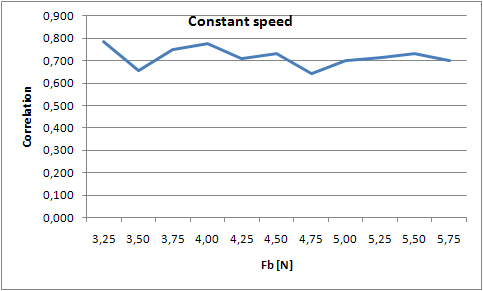 |